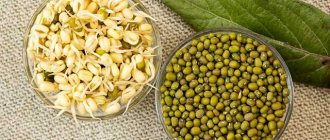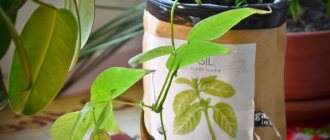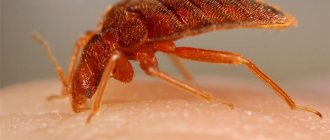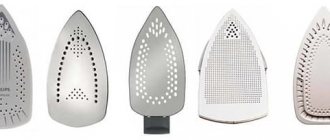How to sprout wheat: YouTube/Human body How to sprout wheat? This question haunts adherents of a healthy lifestyle. Sprouted wheat is an effective dietary supplement. The active substances it contains increase a person’s resistance to stress and strengthen the immune system, which is important during a pandemic. Tips on how to sprout wheat for food will help you make the active supplement yourself.
Why do you need to germinate grains?
When a sprout begins to hatch in the seeds, this activates all processes in them. The resulting greens are rich in minerals and vitamins. You can get sprouts from any grain: wheat, rye, barley, oats. And also from legumes: lentils, peas, chickpeas, beans.
Flax, pumpkin, and sunflower seeds are also suitable. Each of these plants has health benefits in its own way, but wheat is the most popular due to its simplicity and availability.
Sprouting grain crops can serve a variety of purposes, depending on the method and duration of the process.
- For food. Greens are useful to eat, especially in winter, when there are not enough fresh vegetables and fruits in the diet. Wheat grains are especially valued by vegetarians and raw foodists.
- For medicinal purposes. Sprouted cereals have a positive effect on the body, enhance metabolic processes and protective functions, and activate the gastrointestinal tract.
- As a cosmetic product. Skin care products are prepared on the basis of grains: masks, lotions, “washes”.
- For pets. This “grass” is often cultivated for cats that do not go outside. They need it to get rid of fur that gets into their stomach.
- For decoration as an alternative to flowers. Greenery in pots refreshes any room; it is not fussy and requires minimal care. At the same time, it pleases the eye and purifies the air.
- For educational and entertainment purposes for children . Watching the development of plants is a very fascinating process.
On an industrial scale, grains are sprouted to produce malt. In this form, it is easier for microorganisms (yeast) to ferment carbohydrates, which is used in the production of alcohol and beer.
Expert opinion
Many doctors speak positively about the use of sprouted wheat grains. Although they call the product more of a general tonic than a remedy. And yet, its benefits and effectiveness cannot be denied. Thus, nutritionist, candidate of medical sciences Marina Kopytko notes that sprouted wheat grains increase the content of proteins and fiber. It not only helps cleanse the body of waste and toxins, but also normalizes the functioning of the gastrointestinal tract.
From this video you will also learn: will wheat grass help you lose weight? Their benefits and harms. How to eat sprouted wheat correctly, what beneficial substances are contained in the sprouts, what you can cook delicious.
Benefits and harms of consumption
Grains with sprouts contain many nutritional components. Due to the activation of growth processes in grain, the amount of proteins and fats significantly increases, and the proportion of fiber increases. On the contrary, there are fewer carbohydrates. If you add a rich vitamin and mineral composition to this, you get a valuable product.
Sprouted wheat grains have the following beneficial properties:
- activates metabolism;
- promotes weight loss;
- increases immunity;
- has a general strengthening effect;
- stabilizes the functioning of the digestive system;
- improves the condition of skin, nails and hair;
- removes toxins and waste.
What are the benefits of sprouted grains?
How to germinate wheat at home so that it becomes healthy? The article offers several simple step-by-step recipes for obtaining sprouted grains. It is enough to choose 1-2 options and try to germinate them.
What are the benefits of sprouts?
- Regularly adding sprouted grains to your diet helps rejuvenate cells;
- Increases immunity, which is so important in winter;
- Sprouted sprouts help the body in the functioning of the cardiovascular system;
- Reduce blood pressure;
- Improves the quality of vision, condition of hair and teeth;
- With regular use, the digestive system and intestines are cleansed. Biologically active elements found in sprouts prevent the appearance of many pathologies, including oncological ones.
Table 1.4 - Nutritional value of the product per 100 g
| Carbohydrates | 69,89 |
| Squirrels | 14,2 |
| Fats | 2,51 |
| Cellulose | 1,08 |
The calorie content of sprouts is 200 kcal in every 100 grams.
How to choose wheat for germination
Cereals can be sold in a supermarket, at the market by weight, in specialized health food stores and in pharmacies. It is best to buy organic seeds for germination and the same substrate for them, if necessary. But this is the most expensive option.
At the market, cereals are much cheaper, but they can sell products there that were treated with pesticides during agricultural activities and storage. This point must be clarified with the seller.
What to look for when purchasing:
- The seeds must be the same size, shape and color.
- The presence of broken grains, flour or foreign black seeds is not allowed.
- The cereal must be fresh and stored for no more than 1 year.
- High-quality wheat does not allow the smell of dampness, a chemical tint, signs of mold, and especially the presence of moths and other pests.
Many manufacturers sell seeds in convenient bags with holes in which you can soak them and keep them directly in them until they hatch. For example, “Vkusville” wheat for germination is sold in a box containing 3 bags of 50 g each.
Who shouldn't indulge in sprouted grains?
Like any product, sprouted wheat grains can cause harm to our body. For example, if you have an allergy or individual intolerance to this cereal. Therefore, for such people, the article provides recipes on how to sprout wheat for germination and obtain microgreens. Wheat blades of grass have virtually no contraindications.
It is important to start using a minimal amount. You can sprout 1 tsp. grains, use them within 24 hours.
There are no unpleasant symptoms - grow more. If you experience unpleasant sensations, you should not include sprouts in your diet.
Did you like the grains with sprouts? Consume them without forgetting about moderation! And preparing them, as you have already seen, is very easy and quick.
Germination technology
The method of cultivation depends on the purpose. There are two options:
- Obtaining sprouted grain with sprouts up to 2-3 mm. This product is eaten and added to various dishes. In this case, no substrate is needed.
- To prepare medicinal juice, for animals and as a green decoration for the room, grains are grown to grass 12-15 cm high. More often they are cultivated on a substrate (earth, sawdust).
In any case, you will need a container, preliminary preparation of the wheat and suitable conditions for the development of the embryo.
Container
The choice of container is determined by how much product you need to receive. The only option that is not suitable is metal utensils. How you can get wheat germ:
- Multi-tiered sprouters (sprouters). They are made of plastic or ceramic and allow you to simultaneously plant different seeds in significant quantities.
- Jars with lids made of mesh. You can also buy them or prepare them yourself by making holes in the nylon cover. You can simply cover the jar with gauze and tie it with an elastic band. They are installed at an angle with the neck down to allow excess water to drain.
- Any shallow container made of ceramic or plastic (plate, tray, tray). It needs a gauze cover.
- Special microfarms. They work automatically, but are quite expensive. Those who have already tried a diet with sprouts should think about installing such a unit at home.
If you need to get greens, you will need deeper containers or flowerpots with soil. An unusual decor can be obtained by growing grass in shells. It is filled with soil and seeds are sown. For convenience, the shells are placed in egg trays. If you paint it in different colors, it will turn out simply beautiful!
The soil
To cultivate any grain crops, store-bought soil intended for indoor flowers or seedlings is useful. If you take soil from the garden, you need to steam it in the oven or sprinkle it with potassium permanganate to destroy pests. The soil layer in the container must be at least 5 cm.
In addition to soil, coconut fiber, sawdust, woven materials (gauze, burlap), cotton wool, paper towels or napkins are used as a substrate.
Pre-soak
This is an important step that should not be skipped.
- First, you need to wash the wheat well. Remove any grains that float. They are skinny and will not hatch.
- After this, put the grain in a bowl or jar, add water so that there is about 3 times more of it than wheat.
- Leave to swell for 10 hours or overnight.
- After this soaking, drain the water and rinse the grain thoroughly.
Now the wheat is ready for germination.
The necessary conditions
Light as such is not needed to produce sprouts. Containers with soaked grain should not be exposed to the sun; they can be kept anywhere in the room or kitchen. The main thing is that they do not dry out and are always moist. Therefore, it is better to get a spray bottle to moisten the “beds”.
The optimal temperature for embryo pipping is 20-22 degrees.
When cultivating grass, after the greenery appears above the soil surface, it should be kept in a lighted place (on a windowsill), but without direct sunlight.
In the winter months, it is better to illuminate the beds with a phytolamp or fluorescent lamp; a regular incandescent lamp is not suitable for these purposes. As the greens grow, they are watered daily in the morning and sprayed in the evenings.
Step-by-step instruction
Grain, both for animal feed and for human food, is grown in two ways. The first method is to germinate sprouts, which is faster and easier. The second is somewhat more complicated, but it will allow you to get real vitamin-rich greens that your pets will happily eat.
Germination of sprouts
For germination you will need soaked grain. After draining the water from the container with grains, proceed to the next stage.
How to germinate wheat for animal and bird feed:
- Lay the oilcloth on a flat surface. This should be done in a relatively warm room without drafts.
- Spread gauze moistened with water on the oilcloth. Place the grain on it in a small layer - if it is too thick, the wheat may rot and all your work will be in vain.
- Cover the grain with a cloth moistened with warm water. The water should be free of chlorine, and the fabric should be natural.
- Periodically moisten the fabric with warm water, it should not dry out.
- After about two days, the grains will hatch and sprout. In this state they can already be given to animals and birds. The next day, the grains are also suitable for consumption - the sprouts will become even larger and juicier.
The most useful are considered to be grains that have produced sprouts 5-6 mm long. They are the ones who provide serious weight gain.
You can learn about the rules for growing wheat sprouts at home in the following video:
Growing Green Sprouts
Green sprouts or sprouts grown in soil are considered by many to be healthier than sprouts. Grain receives many nutrients from the soil, so green sprouts contain a maximum of valuable elements.
You will need:
- capacity;
- deep container;
- soil, preferably black soil;
- water.
Growing green sprouts:
- Soak and sprout the grain. For this purpose, you can use the method described in the previous section.
- Fill the container 1/2 full with soil. Spread the sprouted grains evenly on top in a thin layer.
- Cover the wheat with soil. Layer thickness – 7-10 mm.
- Water the crops using a watering can with a rain nozzle.
- To make the grain germinate more actively, cover the container with plywood or any other flat and not heavy object. But be sure to leave gaps for air circulation. A microenvironment with high humidity will be created inside and the wheat will quickly germinate.
- After a couple of days, remove the shelter. By this time, white sprouts 2-3 cm long should appear above the soil.
- Move the crops closer to the light. In a few days the green sprouts will appear.
To learn how to germinate green wheat sprouts, watch the following video:
How to properly germinate wheat for food
You shouldn’t take a lot of cereal at one time, 1 glass is enough.
- Before germination, seeds should always be washed and soaked for 8-10 hours.
- After swelling, rinse the cereal again under running water in a sieve or colander.
- In a suitable wide container, place gauze folded in 4-6 layers or natural fabric (cotton, linen) at the bottom.
- Pour the cereal onto it. It must be placed in one layer, otherwise it will begin to warm up, suffocate, and will slowly germinate.
- Cover the top with a piece of gauze folded in 4-5 layers. It should be wet. Place the container in a warm, dark place.
- Every 6 hours, the cereal should be washed with cold water and drained. The liquid in the container should not stagnate.
- Under favorable conditions, the grains will begin to germinate within a day. The sprouts should not be more than 3 mm.
This product is stored in the refrigerator for no more than 2 days, covered with a damp cloth. If you didn’t manage to eat it on time, it’s better to dig the grains into the soil to get greens.
There is nothing complicated about how to quickly germinate wheat. The main thing is to ensure that the cereal does not dry out and mold or musty smell appears. This is why it is important to wash regularly.
Important!
To get 100 g of grains with sprouts, you need to take 70 g of cereal.
Sprouting for treatment
For medicinal purposes, juice squeezed from green mass (grass) is used. To do this you need:
- Take a tray or pot, always with drainage holes at the bottom. Cover them with paper towels or napkins.
- Fill the containers with soil to about 5-7 cm in height.
- Spread the grains that have sprouted the first roots on the surface of the soil. You can simply use pre-soaked wheat, but then it will take a little more time.
- The grains must be laid out so that they touch, but in one layer. There is no need to leave large gaps between them.
- Water the prepared bed with water over the entire surface. Do not cover wheat with soil.
- Cover the top with paper (napkins, newspapers) folded in several layers or cloth. Moisten it well with a spray bottle.
- Raise the cover twice a day to ventilate and moisten the seeds. Keep this up for 4 days.
- After this, remove the shelter and grow for a week or 10 days in diffused light, watering once a day.
Cut the grass when it reaches 10 to 15 cm in height. It is most convenient to do this with scissors immediately before use. A second wave of greenery will soon appear in place of the cut one. For treatment, you should not try to grow a third crop: it will be tougher and not sweet.
Optimal conditions
In order for wheat to sprout vigorously, it is necessary to provide conditions that are comfortable for its growth:
- Temperature. For normal development and growth of wheat, the air temperature should be 22-24°C. Air humidity is maintained high. If the air is very dry, it is recommended to use a humidifier.
- Lighting. The best location for a container with seedlings would be an eastern or western window, since they do not receive direct midday sunlight.
- Watering. Wheat is watered daily. The soil should not dry out, but it should not be over-moistened either, as the grains may burst and become moldy.
Eating
Grains are digested rather slowly and are rich in carbohydrates, so they should be eaten in the first half of the day. The daily dose can be eaten at one time or divided into 2 meals (breakfast and lunch).
Before use, a portion of the product should be rinsed under running water and dried slightly. This will remove the not entirely pleasant grain smell.
The first time you should add no more than 1-2 tsp to the dish. product, eat for 5 days, and take a break on the weekend. Then gradually increase the dosage. By the end of the month you can reach a maximum of 70-100 g per day.
The grains must be chewed thoroughly. If this is difficult, then it is better to grind it in a blender or meat grinder and then add it to food. The product should not be subjected to heat treatment so as not to lose valuable components.
Reviews
★★★★★
Irina Yu. 65 years old, pensioner, Urmary. I use grain sprouts to feed chickens.
I soak it and sprout it, giving it to the birds until the sprouts are very large. Sometimes I give green sprouts, the chickens eat both with pleasure. I also eat sprouts myself – they are good for my health. ★★★★★
Boris M., 55 years old, amateur livestock breeder, Vladimir region. I grow green sprouts for animal feed.
I cut the finished lawns with a knife so that the grain does not spill out. I give one animal 1-2% of its weight. For example, a goat weighing 30 kg receives 300-600 g of green sprouts per day. I give 200-400 g to ten chickens. These sprouts help reduce the number of artificial additives that make meat less healthy and wholesome. Hide
Add your review
Wheat germ is an affordable and effective dietary supplement that can be easily obtained at home. The costs of purchasing grain and its germination are more than offset by increased productivity of livestock and poultry.
0
0
Copy link
Recipes Using Wheatgrass
Grains with sprouts can be used fresh or dried and ground into flour. Here are some examples of dishes:
- The easiest way is to prepare cocktails and smoothies with this healthy ingredient. It is enough to chop two apples with 2 tbsp in a blender. sprouts You can choose a mixture of berries and fruits to taste.
- Add grains to a salad of fresh vegetables dressed with vegetable oil. Any set: cucumbers, tomatoes, peppers, herbs, apples, cabbage. Sprouts go well with all vegetables.
- The crushed seed (raw or dried) is good for use as a breading when frying meat, or added to cutlets instead of bread.
- For dessert, grind 3 tbsp. sprouts with honey and walnuts, taken 1 tbsp.
- For porridge you need to take 2.5 tbsp. sprouted wheat and oatmeal, pour a glass of boiling water over them and let stand for 20 minutes. Combine with berries or nuts to taste.
Small portions of chopped sprouts are added when baking cookies, bread, and muffins.











